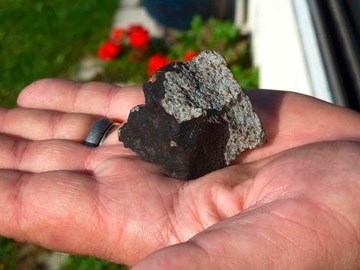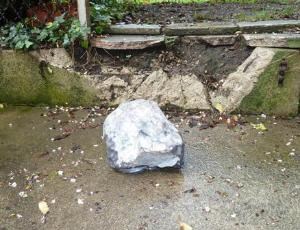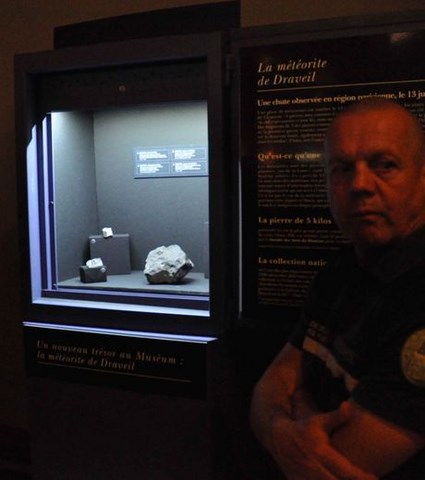The meteorite of Mme Comette
Only 65 meteoritic falls have been historically documented in France over the past four centuries. The latest was discovered in October 2011, when a tradesman repairing a leak in a roof in the Paris suburb of Draveil found a unusually looking stone. The 88gr chondrite meteorite, the size of a chicken egg, covered with a black fusion crust acquired during its crossing of the atmosphere, was trapped in the roofing insulation. The landing had been violent: "Only Superman could have smashed tiles in this way!" declared the roofer, who conjectured rightly that he was faced with a space-traveller, and after having broken off a small piece for himself, handed it over to the mistress of the house, Mme Comette (Nomen est omen!)... Mme Comette, an accountant at the Ministry of Finance in Paris, contacted a meteorite chaser, Alain Carion, who runs a geological gallery in Paris, and who confirmed the nature of the object. He concluded that the fall must have occurred during the summer of that year, when the family was on vacation. The roof had been found leaking after they returned.
Mme Comette was delighted with her meteorite, which she dreamed to transmit to her descendants: "A meteorite in one's garden, it's magical, and more improbable than winning the lotto! It's the history of life on Earth falling here, the history of space of which we know nothing and which is facinating," she raved, but her pleasure was short-lived: the owner of her pavilion, in which she lived as a tenant, M. P. Le Fèvre, claimed the meteorite, declaring: "Mme Comette isn't even the finder of the meteorite, the first person to see it was the roofer, and I am the owner of the place!" He said he wanted to give it to the Museum d'Histoire Naturelle. Did the Museum approach the landlord? The law is not very clear on the subject of ownership: a meteorite is not a mineral resource, but then, it would be more akin, legally, to rain or snow...

The meteorite of Madame Comette
The news and the controversy prompted the Museum d'Histoire Naturelle in Paris to come forward with the information that, actually, another fragment of the meteorite had been found earlier, weighing 205g, also in Draveil, where it had struck a hole into another roof: the fall was dated to the night from the 12th to the 13th of July. The finder, who had remained prudently anonymous, had noticed the hole in the roof of his shed on the 13th. He was "sure it wasn't there before." On July 22nd, he contacted Prof. Albert Jambon, from Université Pierre-et-Marie-Curie (a.k.a. Paris-VI), a meteorite specialist, and Pierre-Marie Pelé, a meteorite hunter, who were at the receiving end of an email address ouvertlanuit[at]cieletespace.fr at a French astronomical website, "Ciel et Espace," which had issued a call for witnesses, following a dramatic fire-ball apparition in the sky over Bretagne between 05:20 and 05:30 on the morning of July 19th: witnesses in Nantes saw a very bright light in the sky, and a few minutes later, a tremendous noise of thunder, or "of a sonic bang" woke up the inhabitants of the region around Rennes, a noise described by some as "as if lightning had struck in the garden," and preceded, according to eye-witnesses, by the passage of an extremely bright and rapid object.
Ciel & Espace quotes the owner of the first Draveil meteorite to have dated the fall to July 12th-13th, but dates the fire-ball event to July 19th. In fact, these were distinct events. The finder of the meteorite came forward in response to the call for witnesses of the widely publicized fire-ball. No meteoritic material was recovered to this day of the "Bretagne meteorite" of July 19th, 2011. Another spectacular bolide exploded over the Toulouse region on August 2nd, at 03:30 of the same year. And yet another on October 21th over the same Paris suburbs, where only a few days earlier the meteorite of Mme Comette had been discovered... No meteoritic stones from this two events have been found... France gets hit with the most meteorites per capita of any country in the world. A statistic which must be function of a density of population which is high enough for casual observers to cover most events, but not so high as to bring up the ratio, in comparison with other countries; and to an awareness of meteorites in the population which no doubt goes back to the heated controversies of the past two centuries.
The Museum d'Histoire Naturelle received a gift of 80g of the meteorite. The website does not say where the remaining 125g went. The find was kept quiet - in order for the residents of Draveil not to be exposed to nuisances from meteorite hunters, says Professor Jambon. These precautions went to naught after the discovery at the home of Mme Comette - M. Alain Carion, the expert whom she had contacted, and his son Louis, scoured the neighborhood during the following days, checking cars for dents and leaving leaflets with the residents, in the hope of finding more fragments.
Prof. Jambon was furious: "M. Carion knew full well that we were in the possession of a sample originating from the same fall and he did not inform us of his find, which would have been useful to help determine the trajectory of the fall and to find more fragments. Instead, he alerted all the medias, pretending that he was the only one who had followed the scent of the Draveil meteorite."
M. Carion defends himself: "The scientists are furious because I was first on the media front. They insist that I should give them my sample, but as they already have one, I don't see what's the scientific interest..."
A.M. de G.
However, the media attention, and the descent of droves of amateur meteorite hunters upon Draveil, kicked Université Pierre-et-Marie-Curie and Prof. Jambon into action and they issued an appeal to witnesses on October 13th. And it was a good thing they did, for two more, and considerably larger pieces were recovered as a result (the location, dates and finders remaining undisclosed): a 2 K stone which fell on an industrial compound in Grigny, and the biggest piece found to this day: of 5.2 K, which fell in a garden in Savigny-sur-Orge, where it broke a step. The fall of the latter had actually been witnessed by a mailman. It was concluded that the date of the fall of the stones had been July 13th, around noon. The day was overcast, no fire ball would have been visible, and any rumbling would have been taken to be thunder (or early firecrackers for Bastille Day, on the 14th). The four fragments of the meteorite of Draveil, including the fragment of Mme Comette (the legal strife must have found some conclusion), have been solemnly put on permanent display at the Museum d'Histoire Naturelle, and placed in the Grande Galerie de l'Evolution (despite the fact that the stones contain no clue whatsoever about "building blocks" of life...)

The 5.2 K fragment as found at Savigny-sur-Orge

Photo Cedric Guigon
Source:Le Parisien, October 9th & 12th, 2011
Ciel et Espace, July 20th and October 11, 2011

